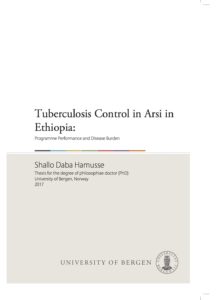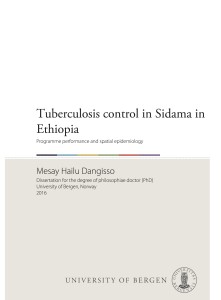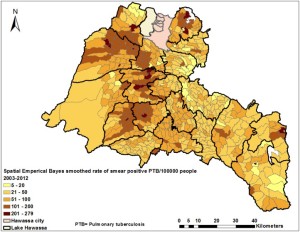

Hamusse SD. Tuberculosis Control in Arsi in Ethiopia: Programme Performance and Disease Burden. PhD. University of Bergen, 2017. Bergen
Tuberculosis (TB) remains a high-priority communicable disease that causes an enormous burden of morbidity and mortality, and infects one-third of the world’s population. It is the second leading cause of death among infectious diseases worldwide, with more than one-fourth of all preventable adult deaths in developing countries due to TB. The disease disproportionately affects people in resource-poor settings, particularly those in Asia and Africa. In addition, more than 80% of TB cases and 78% of deaths occur in developing countries.
The primary causes of the TB epidemic in developing countries are poor socio-economic conditions, an increase in human immuno-deficiency virus and an increase in anti-TB drug resistance, especially the MDR-TB strain. The weak and ineffective national TB control programmes, the poor implementation of infection prevention measures, the poor quality and accessibility to anti-TB drugs, the irrational use of anti-TB treatment regimens and the poor patient adherence are the underlying causes for the emergence of drug- resistant strain including MDR-TB. The emergence of this strain therefore poses another challenge to TB control efforts.
TB control aims at detecting infectious TB cases as early as possible, and puts them on standardized anti-TB treatment in order to successfully treat and break the chain of transmission and to avert the emergency of multi-drug resistance. The effectiveness of the TB control strategy mainly depends on the timely diagnosis and treatment of smear-positive pulmonary tuberculosis. The cure of smear-positive pulmonary TB patients is considered to be an important intervention mechanism for the primary prevention and emergency of MDR-TB. As a result, a rapid identification of smear-positive pulmonary TB cases and their effective treatment using combined anti-TB drugs is the cornerstone of the global TB control programme.
In 1993, the World Health Organization (WHO) confirmed TB as a global public health emergency and recommended the Directly Observed Treatment, Short Course (DOTS) as a standard strategy to control the disease. In 1994, the World Health Organization designed a Framework for Effective Tuberculosis Control, which clearly designated the core elements of the DOTS strategy. DOTS aims at detecting 70% of infectious TB cases and successfully treating 85% of them to interrupt the transmission, reduce mortality and prevent the emergence of drug resistance.
Ethiopia is among the 22 high-TB-burden countries and the 27 high-MDR-TB-burden worldwide. TB is the leading cause of hospital admission and second leading cause of death in the country. The WHO recommended the DOTS strategy, which was piloted in 1992 and nationally launched in 1995, in a few health facilities with a subsequent expansion to all public health institutions. As a result, in 2015 all public and 14% of private health institutions were covered. The overall aim of this thesis is to assess the trends in TB control performance, and to estimate the burden of the disease at the community level to help achieve a better understanding of the gap in improving the TB control programme in Ethiopia.
The thesis investigates TB control performance, and estimates the disease burden at the community level. The studies focus on assessing trends in TB case notification and treatment outcomes. In addition, we estimate the prevalence, incidence of bacteriologically confirmed TB cases, as well as the burden of primary and secondary drug resistance TB at the community level. The findings of the studies could also be used to explore area-specific strategies help to improve TB control programmes in Ethiopia.
The studies were conducted in Arsi in central Ethiopia, and used cross-sectional and prospective cohort study designs. The studies were conducted in predominantly rural communities and at public health institutions. Most of the papers focus on smear-positive TB, the most infectious form of TB.
The study findings show that the trend in PTB+ case notification increased in parallel with the expansion of DOTS population coverage from 18% to 70% over 15 years. The PTB+ case notification increased from 7 to 63 per 100,000 population in 15 years, with an overall increase of 89%. The TB case detection rate (CDR), estimated by the proportion of PTB+ cases notified from the total annual expected PTB+ incidence of the zone, went up from 6.4% to 58.7% over the study period. The overall 15-year average PTB+ case CDR of the zone was 37.7%, which was far below the 70% global target. Moreover, the PTB+ case notification varied across the 25 districts of the zone. The rural residence and population ratio to DOTS sites and age of the patients were associated with a low TB case notification.
Between 1997 and 2011, the treatment success rates for smear-positive TB rose from 61% to 91%, with a corresponding decline in treatment failure and default rates. The 15-year average cure rate was 67%, which was lower than the global target of an 85% of cure rate. However, treatment outcomes varied across the 25 districts of the zone. The treatment success rate was also found to be associated with the age of the patient, the patient category and TB/HIV co-infection.
Trends in case notification and treatment outcomes are used as proxy indicators to evaluate the TB programme performance. However, to obtain a better understanding of the impact of the TB control programme, we need both baseline and follow-up data on the disease prevalence, incidence and drug resistance burden at the community level. Considering the shortage of resources, we used a less expensive method to estimate the prevalence and incidence of PTB+ and primary and secondary drug resistance, using symptom inquiry followed by sputum microscopy for AFB, culture and a drug-susceptibility test.
The results show that there is a high incidence of PTB+ cases. For every case PTB+ on anti-TB treatment, there was an almost equal number (0.96) of undiagnosed BCTB cases in the community. Furthermore, we identified more men undergoing treatment before the survey, whereas more women were detected during the active TB case finding. The history of TB contact was found to increase the risk of developing active TB, thus suggesting the targeting of contact-tracing among household members diagnosed with PTB+ to help capture the undetected infectious TB cases in the community. The estimation of TB prevalence and incidence based on symptom inquiry and sputum microscopy is a less expensive and simple technique. This method might help to generate information on the magnitude of TB in resource-constrained settings.
We also found that there is a high prevalence of primary and secondary resistance to any one or more first-line anti-TB drugs and primary and secondary MDR-TB in the study area. The highest prevalence of secondary drug resistance was identified among previously treated TB cases compared to primary resistance among new TB cases. This is primarily due to the poor treatment outcomes among previously treated cases caused by lost follow-up and irregularity of drug intake.
The overall 15-year average PTB+ case CDR was 38%, while the cure rate was 67%. So, after 15 years of the DOTS programme, the high proportion of undetected infectious TB cases in the community, combined with increasing primary and secondary drug resistance TB, we conclude that there has been a sub-optimal DOTS performance. Hence, this thesis underscores the need to improve DOTS performance through devising alternative strategies in TB control programmes in Ethiopia.
The thesis can be downloaded here




